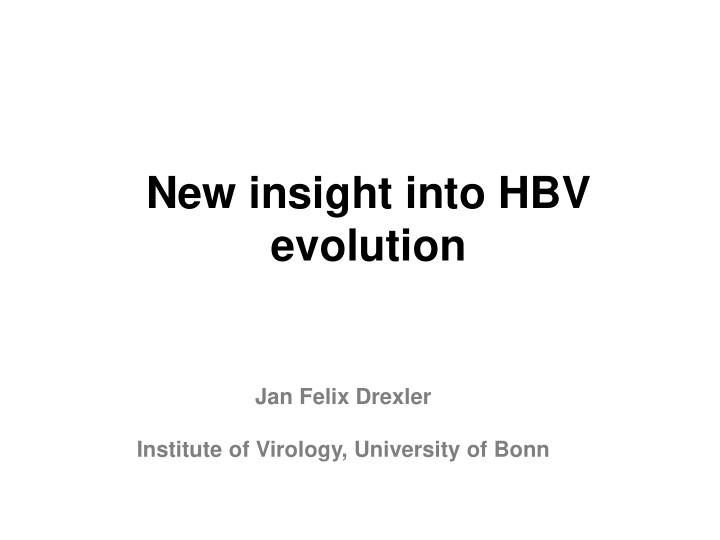



New insight into HBV evolution Jan Felix Drexler Institute of Virology, University of Bonn
How old are hepadnaviruses – endogenous bird & reptile variants well >60 million years Suh, PLoS Gen, 2015
Consistent with diverse hepadnaviruses in lower vertebrates Mammal-like? Dill, J Virol, 2016
Hepatology, 2012 Slow long-term evolution: Mummy HBV near-identical to contemporary strains
Extant bats are old mammalian lineages – introduction of ancestral HBV into mammals? Simmons, Science 2005
Screening of 3,000 bats for HBV Drexler/Geipel et al., 2013, PNAS
3 viruses Tent-making bat U. Bilobatum TBHBV Roundleaf bat 1 H. Ruber RBHBV 2 3 Horseshoe bat R . Alcyone HBHBV natalie's Life List, inaturalist.org
Relevance of bats - Chiropteran hosts harbor largest hepadnavirus diversity within mammals Two HBV species in primates: HBV WMHBV Rasche et al., Curr Opinion Virol, 2016
Primate HBV ancestors: Acquisition of bat viruses by monkeys? Rasche et al., Curr Opinion Virol, 2016
Lack of studies into New World non-human primates 4 studies in 45 years 123 animals 9 species
Brazil: 5 th largest country Highest primate diversity worldwide Brazil 118 species
Screening of ca. 100 NHP A new primate HBV species: CMHBV Dominguez/König/Rasche et al., unpublished
Potentially chronic infection: core deletions and no signs of inflammation Dominguez/König/Rasche et al., unpublished
Deep HBV sister lineages in new world monkeys Dominguez/König/Rasche et al., unpublished
Evidence for ancient co- speciation of primate hepadnaviruses and their hosts – but not for HBV Dominguez/König/Rasche et al., unpublished
Ancestral state reconstructions Primate hepadnavirus origins in NHP HBV in humans? Dominguez/König/Rasche et al., unpublished
Hypothesis testing You are here! HBV may have evolved in hominoid ancestors 17 million years ago Dominguez/König/Rasche et al., unpublished
No evidence for ancestry of F/H in American monkeys Introduction along human migration? Dominguez/König/Rasche et al., unpublished
In sum • Hepadnaviruses are an extremely old virus family • Primate hepadnaviruses may be the result of a host switch millions of years ago • HBV likely evolved in hominoid ancestors, preceding the human stem lineage • Divergent New World genotypes F/H may originate from pre-historic human migration
EMC, Rotterdam Virology, Bonn Funded by Ab Osterhaus Christian Drosten Thijs Kuiken Victor Max Corman Debby van Riel Monika Eschbach-Bludau JMA van den Brand Sebastian Brünink Tobias Bleicker Virology, Berlin Andrea Rasche Detlef Krüger Marcel Müller Virology, Giessen Dieter Glebe KCCR, Kumasi Virology, Heidelberg, Augustina Annan FLI, Riems Samuel Oppong Ralf Bartenschlager Rainer Ulrich Mexico Martin Beer Virology, Hannover Álvaro Aguilar Setién Georg Herrler Ulm Veterinary Medicine, Salvador Elisabeth Kalko Roberto Franke Bernhard Nocht Institut, HH Marco Tschapka Eduardo Netto Thomas Kruppa Jonas Schmidt-Chanasit Chumakov Institute, Moscow Stellenbosch Alexander Lukashev Wolfgang Preiser RIVM, Netherlands CIRMF, Franceville Sonja Matthee Chantal Reusken Eric Leroy Kruger NP ILRI, Kenya AFMB, Marseille Danny Govender Bruno Coutard Jörg Jores
Recommend
More recommend